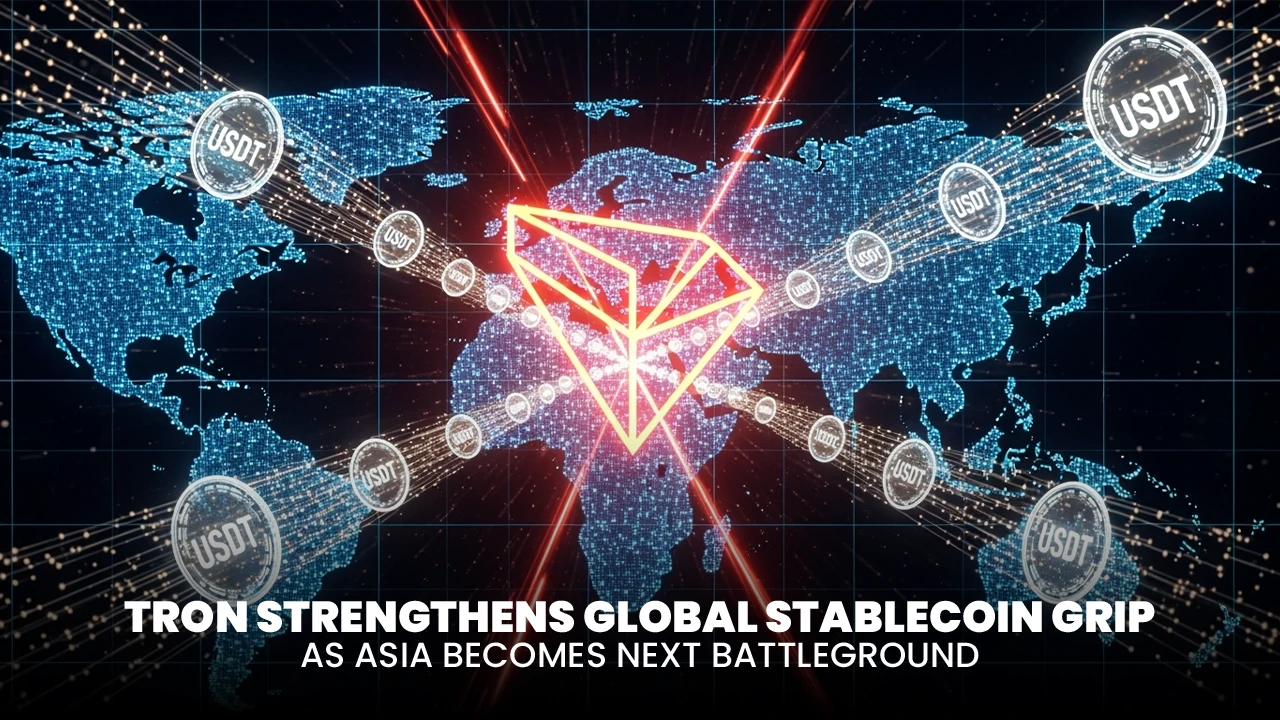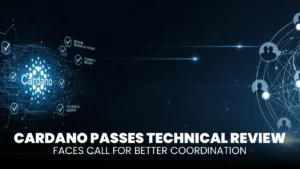Tron Strengthens Global Stablecoin Grip as Asia Becomes the Next Battleground

Tron is strengthening its foothold in the global crypto landscape, moving beyond its dominance in Latin America to capture growing market share in East Asia. USDT transfer volumes in the region are climbing at a rapid pace, reflecting the increasing reliance on Tron’s network for cross-border payments and everyday transactions.
- Asia Adoption Meets Regional Finance Dynamics
- Key Metrics at a Glance
- Institutional and Retail Adoption Stories
- Regulatory Landscape and Payroll Innovation in Asia
- Market Sentiment and Price Dynamics
- The Effect: Remittance and Retail Use Cases
- Smooth Growth Powered by DPoS Infrastructure
- Conclusion
- Frequently Asked Questions for Tron Strengthens Global Stablecoin Grip
- Why is TRX expanding more rapidly in Asia now?
- How much of global USDT runs through Tron?
- What institutional tools are supporting TRX’s adoption?
- How does TRX support remittances and retail users?
- Is TRX token performance consistent with infrastructure growth?
- Glossary of Key Terms
Its appeal lies in the ability to deliver speed and affordability at scale, something that resonates with both individual users and institutions looking for practical blockchain solutions.
This momentum is fueled by Tron’s Delegated Proof of Stake system, which keeps transactions efficient and costs negligible even as activity surges. The timing could not be better, with regulators in Hong Kong and South Korea laying out clearer frameworks for stablecoin use and conversations around a potential Yuan-backed digital currency gaining ground. Together, these factors are turning Tron into more than just a popular blockchain it is becoming a vital piece of financial infrastructure in Asia’s digital economy.
Asia Adoption Meets Regional Finance Dynamics
In East Asia, especially Hong Kong and South Korea, Tron usage is accelerating. CoinDesk data shows that Tron handles 50% of the global USDT stablecoin supply and around 61 percent of stablecoin market cap flows through the chain.
Hong Kong has passed a stablecoin law in May 2025, while Asia’s financial markets prepare for formal stablecoin issuances early next year. That regulatory clarity, combined with Tron’s DPoS network, makes it a timely platform for institutions and retail users alike.
Key Metrics at a Glance
| Metric | Value |
| Monthly stablecoin transfers | Over $600 billion (Crypto Briefing) |
| Global USDT share on Tron | 50 percent; 61 percent of stablecoin market cap (Crypto Briefing) |
| Countries where Tron is top chain | 35 of 50 measured (Crypto Briefing) |
| Accounts & transactions | Over 300 million accounts; rapid user growth (Mitrade, Wikipedia, CoinDesk) |
| Technical throughput | 2,000 TPS via DPoS (Crypto Briefing, Wikipedia) |
Institutional and Retail Adoption Stories
At WebX2025 in Tokyo, Tron’s founder Justin Sun announced that the network now accounts for over $82 billion in USDT issuance. He also stated that over one million daily independent accounts use Tron for USDT transfers.
Tron’s DPoS consensus enables that scale while maintaining low fees. Justin Sun emphasized its regulatory cooperation in freezing over $250 million in illegal assets, tied to its T3FCU initiative.
On the institutional front, Tron’s integration with MetaMask introduced its ecosystem to over 100 million users, unlocking exposure to its DPoS network and DeFi products. MetaMask’s expansion effort highlighted Tron’s adoption across Asia, South America, and Africa.
xStocks, the tokenized equities platform, now trades $2.5 billion worth of stocks in TRC‑20, expanding Tron’s DPoS‑based infrastructure to real‑world asset markets.
ALSO READ: Eternl Wallet Project: Cardano’s First Treasury Payout Fuels $71M Upgrades
Regulatory Landscape and Payroll Innovation in Asia
Hong Kong’s stablecoin regulatory framework, expected to license issuers early 2026, complements Tron’s low-cost, fast-throughput DPoS network, offering an on‑chain distribution option for institutional clients.
Payroll firms in Asia are adopting Tron for remittance and corporate payments. OneSafe notes that more than 51% of USDT and 273 million transactions in May 2025 ran through Tron. Gas‑free USDT transfers and DPoS governance simplify integration for payroll systems.
Market Sentiment and Price Dynamics
TRX price remains resilient. It trades above the 20‑day moving average, with charts showing bullish technical momentum toward a $0.40 target.
This strength follows news of Tron’s expansion into Asia and its stablecoin leadership, boosting investor confidence.
The Effect: Remittance and Retail Use Cases
In Latin America and now in Asia, the majority of Tron stablecoin transfers have been less than 1,000. The trend is an indication of the increasing popularity of the platform as a solid remittance channel among retail customers. The remittances made by migrant workers frequently incur high charges and take a long time when using conventional channels such as banks or wire services.
The Delegated Proof of Stake (DPoS) architecture of Tron changes this with the ability to make settlements faster with negligible costs, so that users can keep more of what they make. Tron is making a difference in millions of small-value transactions per day to provide families with access to critical finances in real time, rather than the days of waiting on international wires.
In the Asian region, this trend is especially high in corridors linking Hong Kong to countries in Southeast Asia, such as the Philippines, Indonesia, and Vietnam. Such countries rely largely on incoming remittances, and the low-cost DPoS activity of Tron is facilitating the transfer of funds back to their home countries by workers living and working overseas.
Employers and payroll companies have also begun to implement stablecoin transfers through Tron to enable cross-border salaries to be paid in a timely manner, reducing the risk of exchange rate volatility. It is not only the adoption by the retail sector but also the use by corporations that shows how Tron can fill gaps created by the traditional financial infrastructure.
Smooth Growth Powered by DPoS Infrastructure
Tron’s steady expansion from Latin America into Asia demonstrates the strength of its DPoS-driven growth strategy. In Latin America, the network rose to dominance by offering a hedge against unstable local currencies while providing affordable remittance rails.
That proven model is now being replicated in Asia, where both regulators and institutions are looking for scalable blockchain settlement systems. The network’s 27 Super Representatives validate transactions quickly and securely, enabling Tron to handle thousands of transfers per second without compromising reliability.
This combination of speed and cost efficiency has positioned Tron as an attractive choice for both individuals and institutions. As Hong Kong and South Korea move toward clearer stablecoin regulations, Tron is ready to extend its infrastructure into markets where demand is increasing rapidly.
Market sentiment and on-chain data indicate that the growth is more than hype, with rising daily wallet activity and billions in stablecoin flows confirming its relevance. Even if TRX faces short-term volatility, the fundamentals of Tron’s DPoS system point to a stable long-term role in global finance.
ALSO READ: Sui Unlocks Bitcoin Liquidity on Merlin Chain, Launches 5th SuiHub in Asia
Conclusion
Tron’s Delegated Proof of Stake-powered network has emerged as a core layer for global stablecoin transactions. Processing over $600 billion each month and hosting more than half of all USDT activity, it has secured a role as one of the most active blockchain settlement platforms in the world. Its one million daily users highlight the real-world demand behind its adoption, proving that the network is not just speculative but a vital tool for everyday transactions.
The expansion into Asia is accelerating this momentum. With regulatory frameworks taking shape in Hong Kong and growing adoption among payroll firms and financial institutions, Tron is building on its Latin American success to cement its position globally.
Retail users continue to benefit from quick, low-cost transfers, while institutions are exploring tokenized assets and other advanced applications on the same infrastructure.
Frequently Asked Questions for Tron Strengthens Global Stablecoin Grip
Why is TRX expanding more rapidly in Asia now?
Because of improved regulation in places like Hong Kong, TRX’s fast DPoS network offers an affordable, compliant infrastructure for stablecoin transactions.
How much of global USDT runs through Tron?
Around 50 percent of USDT by circulation and 61 percent by stablecoin market cap flows on the Tron network.
What institutional tools are supporting TRX’s adoption?
Key integrations include MetaMask (access to 100 million users), xStocks (tokenized equities), and payroll systems supported by gas-free USDT payments.
How does TRX support remittances and retail users?
Most TRX USDT transfers are under $1 000, reflecting its role in high-frequency, low-cost remittances across emerging markets.
Is TRX token performance consistent with infrastructure growth?
TRX trades above its 20-day average and benefits from positive market sentiment. Open interest is surging, indicating trading support amid wider adoption.
Glossary of Key Terms
- DPoS (Delegated Proof of Stake): A consensus mechanism where token holders elect delegates (Super Representatives) to validate transactions, enabling high throughput and low fees.
- USDT (Tether): A dollar-pegged stablecoin widely used for global transfers and DeFi liquidity.
- TVL (Total Value Locked): The value of assets locked in a blockchain’s DeFi ecosystem, indicating network utility.
- Gas-free Transactions: Network transfers where fees can be paid in stablecoins themselves, reducing friction for users.
- xStocks: A platform issuing tokenized equities (Apple, Tesla etc) as TRC-20 tokens, enabling fractional ownership and 24/7 trading.
- Stablecoin Transfer Volume: The total value of stablecoins moved through a network, illustrating the scale of usage.




